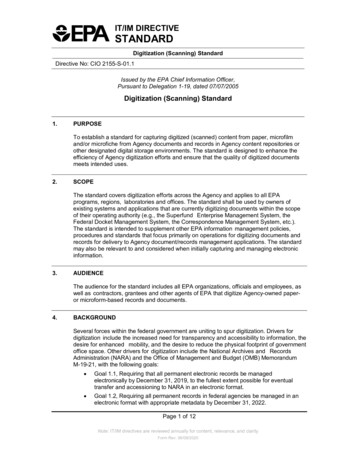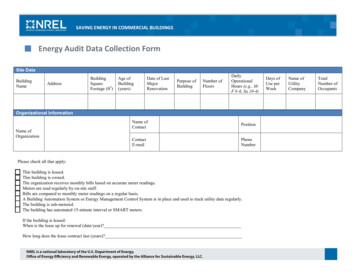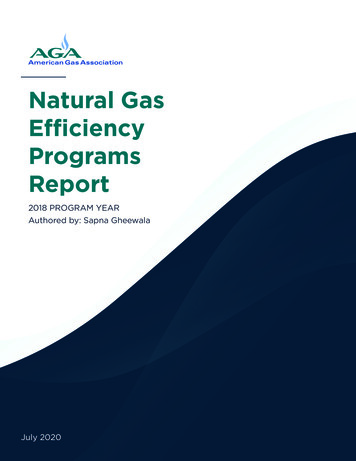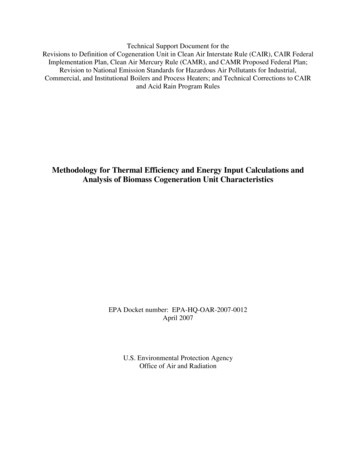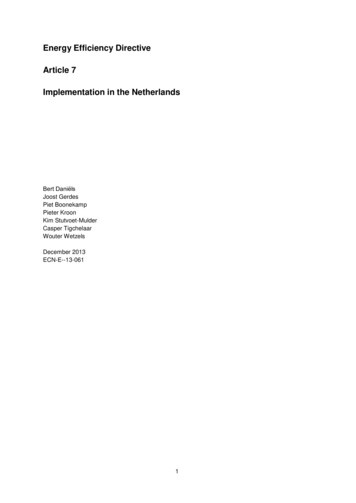
Transcription
Energy Efficiency DirectiveArticle 7Implementation in the NetherlandsBert DaniёlsJoost GerdesPiet BoonekampPieter KroonKim Stutvoet-MulderCasper TigchelaarWouter WetzelsDecember 2013ECN-E--13-0611
AccountabilityThis report has been prepared on behalf of the Ministry of Economic Affairs as the Dutch contributionto Article 7 of the Energy Efficiency Directive (EED). It describes how the Netherlands intends toachieve the target defined in Article 7 of the EED. It discusses the interpretations adopted andchoices made by the Dutch government with regard to implementation of the EED, the consequencesfor the Netherlands and the expected savings that will be necessary in order to reach the target. Thecalculations relating to the target and policy impacts were carried out by the Energy Research Centreof the Netherlands (ECN), with contributions in relation to agriculture from Nico van der Velden andPepijn Smit of the Landbouw Economische Instituut [Agricultural Economics Research Institute]. ECNhas provided support for the Dutch government in defining the interpretations and choices relating tothe EED but this report is not an assessment of these by ECN.ECN wishes to thank the members of the inter-departmental project group which has been involvedin the process that has resulted in this report: Linda Brinke (Ministry of Finance), Hans Cahen, MartijnRoot, Erik Schmersal, Ralf Vermeer (Ministry of Economic Affairs), Kristel Wattel-Meijers (Ministry ofthe Interior and Kingdom Relations).The contact person at the Ministry of Economic Affairs is Marc Streefkerk and the contact person atECN is Bert Daniëls (tel 088 5154426, daniels@ecn.nl). The ECN internal project number is 5.2116.AbstractArticle 7 of the recently adopted Energy Efficiency Directive obliges the EU Member States toachieve 1.5% yearly efficiency improvements during the period 2014-2020, culminating in acumulative savings target. This report describes the way the Netherlands intends to meet the Article7 obligations, as requested by the European Commission.The EED offers the Member States various degrees of freedom with regard to the definition of thetarget and the way it is met. Hence, this report addresses the choices of the Netherlands and theirconsequences for the Dutch target and the realised energy savings. A broad-lined description of thechoices and overall results is complemented by extensive annexes that offer technical descriptionsand detailed numbers.Although the information which appears in this report has been obtained from reliable sources and the necessary care hasbeen taken in preparing the report, ECN can accept no liability towards users in respect of errors, inaccuracies and/oromissions, whatever their cause, or for any resulting loss or damage. The use of the information in this report and anydecisions taken by the user on the basis of it are at the expense and risk of the user. ECN, its managers, directors and/oremployees shall under no circumstances be liable for indirect, non-material or consequential loss or damage including loss ofprofit or income and loss of contracts or orders.2
ContentsReading guide411.11.21.3SummaryScope – objective and policy impactNet target to be achievedExpected impacts of Dutch policy555522.12.22.32.42.5Savings target for the NetherlandsTotal energy saving targetFinal versus primaryCumulative targetBaselineAdjustments to the target based on Article 7(2) and (3)77889933.13.23.33.43.53.63.7Expected policy impactsSummaryDefining the contribution of policyBuilt environmentIndustryAgricultureTransportAdditional ambitions of the Energy Agreement1111111415171818References20Explanatory notes – calculation of the targetExplanatory notes – calculation of policy impactsPolicy impacts, totals and phasingChoices and scope for interpretation in the EEDMonitoringDescription of the basic approachList of policy instrumentsEnergieakkoord [Energy Agreement]Calculating the impact of energy taxationEquivalence with obligation I.J.3
Reading guideThe summary and sections 2 and 3 of this report provide a broad-brush description of the choicesoffered by the EED, the way in which the Netherlands has handled them and the implications withregard to the associated target and the energy savings resulting from Dutch policy. Thesesections are intended to provide information for a broader target group: stakeholders within theNetherlands as well as the European Commission.The annexes contain a more detailed, in-depth discussion of the same subject matter. The mainobjective of the annexes is to set out all the information requested by the European Commission.The main target group for the annexes is European Commission experts.The summary table below shows where the information requested by the European Commission,or parts of that information, appear in the report.Table 1: Table summarising the information required by the European Commission,indicating the sections of the report where this information appearsInformationIntermediate periods for reporting savingsTarget (cumulative)- Final or primary- Years before baseline (historical savings)- Eurostat or national data- Consumption as a raw material- Correction for generation for own use- Inclusion of the transport sector- Inclusion of ETS companies, inclusion of earlyactions & savings by supply sectors?- Achieving 25% reduction- Phasing of cumulative savings targetObligation or alternative policyEquivalence with obligation schemeSavings (cumulative)- Savings by sector- Policy measures for savings- EU versus national policy (standards)- Methodology for calculating savings- Deemed / surveyed / scaled savings- Taxes and savings- Preventing overlap between effects (doublecounting)- Additionality measures/autonomous savings- Lifetime of savings- Annual versus cumulative savingsM & E process / other- Policy safeguards (compliance)- Sustainable energy generated by consumers(observed)- Demonstrable and material- Savings, EPBD standards, new buildings- Monitoring & evaluation system- Climatic variations within the country4LocationAnnex H1.1, 1.2, 2.1, 0, Annex A1.1, 1.2, A , Annex E2.4, Annex A2.4, Annex A, Annex DAnnex AAnnex A2.4, Annex A, Annex D2.5. Annex A, Annex D2.5, Annex A, Annex D1.3, 0, 2.4, 2.5, Annex A, Annex D1.2, 3.1, Annex DAnnex J1.1, 1.3, 3.1, Annex B3.3-3.6, Annex A3.1, 3.2, 3.3-3.6, Annex G1.3, 3.2, 3.3, 3.7, Annex B, Annex D2.5, 3.2, Annex BAnnex B3.2, 3.3, 3.5, 3.6, Annex B, Annex I3.2, Annex B3.2, 3.3, Annex B, Annex DAnnex A1.3, Annex A3.2, 3.3Annex DAnnex B3.3, Annex DAnnex EAnnex B
1. Summary1.1Scope – objective and policy impactThis report explains how the Netherlands intends to meet its target as defined in Article 7 of theEED. It is based on the interpretations and choices that the Dutch government has made.Target for the NetherlandsArticle 7 of the Energy Efficiency Directive obliges the Netherlands to achieve an efficiencyimprovement of 1.5% per year in the period 2014-2020, as a cumulative target. For theNetherlands this means a target of at least 482 PJ savings on final energy consumption – aftertaking account of the degrees of freedom offered by the EED.Expected savings by the NetherlandsThe Netherlands expects to achieve cumulative savings of between 387 and 562 PJ in final terms,of which 87 to 186 PJ will be through new policy. This new policy consists of policy measuresagreed in the recent Energieakkoord [Energy Agreement] concluded under the auspices of theSociaal Economische Raad [Social and Economic Council of the Netherlands] (SER). The cabinethas also signed this agreement.1.2Net target to be achievedArticle 7 assumes that an obligation scheme will be created, but also offers Member States theoption of achieving an equivalent target by means of alternative policy. The Netherlands haschosen this latter option.Article 7 of the EED requires the Netherlands to achieve a 1.5% efficiency improvement per yearin the period 2014-2020 compared with average consumption in 2010-2012, and translates thisinto a cumulative target. This requirement is over and above the efficiency improvement resultingfrom European policy.For the Netherlands, this would be 643 PJ. But after taking advantage of the provisions of theEED and the degrees of freedom that it offers, the remaining net target for efficiencyimprovements on final use to be achieved during the period 2014-2020 is approximately 482 PJ.1.3Expected impacts of Dutch policyExpected savings – highlightsThe target relates to energy savings which take place between 2014 and 2020 and can beattributed to national policy. This target is not in addition to current policy efforts; the savingsimpacts of existing national policy also count. It does not matter whether this national policy waseffective before 2014 or comes into force from 2014 onwards, provided that the savings measuresthat can be attributed to it – referred to in the EED as ‘new actions’ – are in place between 2014and 2020. The impacts of European policy cannot be included. If Europe obliges Member Statesto introduce policy but it is implemented at national level, its impacts can be counted as national5
policy. Where national policy goes further than European policy, national policy only counts if theresults are over and above the impacts of European policy; for example, savings relating toelectrical appliances only count if they are higher than those required by the European EcodesignDirective.Because the target is cumulative, energy-saving measures which are implemented earlier in theperiod 2014-2020 will contribute more to the target than the same measures in later years. Anenergy-saving measure introduced in 2014 will count for 7 years, whereas a measure introducedin 2020 will only count for 1 year. The phasing of policy impacts – i.e. when an energy-savingmeasure is actually put in place – therefore makes a lot of difference to their contribution towardsthe target.It is estimated that the total cumulative savings that can be attributed to Dutch policy – existingand new – in accordance with the EED are between 387 and 562 PJ.Existing policy will contribute between 266 and 410 PJ. The bandwidth is due to uncertainties withregard to economic growth, energy prices and the effectiveness of policy measures.BandwidthsThere are significant uncertainties with regard to the expected impacts that can be attributed to apolicy. Therefore, where an estimate of these uncertainties is available, the report providesbandwidths around the most likely expected impacts. This applies both to the individual policypackages and to the totals per sector and for the Netherlands as a whole. The bandwidths reflectthe upper and lower values between which the policy impact is likely to lie. The most probableimpacts do not necessarily lie in the middle of the bandwidth.Adding bandwidths to produce totalsThe bandwidths for the individual packages cannot be added together to produce totals by sectoror on a national basis. If this were the case, it would mean that the total bandwidth containedsituations in which everything was proceeding both well and badly at the same time, and it is veryunlikely that this would happen. The aggregation into sectoral and national bandwidths takes thisinto account, but the consequence of this is that the bandwidths cannot be added together.New policy is based on the policy agreed in the Energy Agreement and contributes between 87and 186 PJ. The bandwidth here is much greater, relatively, than for existing policy. This is due touncertainty about the precise details of the policy intentions defined in the Energy Agreement.Of the total savings to be achieved, 130-211 PJ will take place in households, 32-136 PJ inservices, 108-222 in industry and 12-21 in agriculture.Table 2: Total expected savings, existing and newExpected due to existing newOf whichSavings due to existing policySavings due to new policyEnergy Average17082166Max.211136222Table 3: Total expected savings, distribution by sectorMin.13032108Savings by households, existing and newSavings by services, existing and newSavings by industry, existing and new6
Savings by agriculture, existing and newSavings by transport, existing and new1234164021462. Savings target for the Netherlands2.1Total energy-saving targetThis section describes how the target for the Netherlands was obtained, and how the choicesmade by the Netherlands under the EED determine the resulting target.Article 7 of the EED obliges the Netherlands to achieve a 1.5% efficiency improvement per year inthe period 2014-2020 compared with final consumption in the period 2011-2013. The Directivetranslates this into a cumulative target: the aggregated savings in the years 2014-2020. For theNetherlands this means that – after taking advantage of the provisions and degrees of freedomoffered by the EED – the target for efficiency improvements on end use to be achieved during theperiod 2014-2020 is approximately 482 PJ final.The next sections describe step by step how the target for the Netherlands has been calculatedon the basis of the choices that the Netherlands has made.Comparison of Article 7 of the EED with previous Dutch savings targetsThe savings target of 1.5% as defined by the Directive cannot be compared with previous nationaltargets in the Netherlands, such as 2% energy savings for the period 2010-2020 according to theProtocol Monitoring Energiebesparing [Energy Saving Monitoring Protocol] method. The tableillustrates a number of important differences.Table 4: Summary of differences between energy saving targetsEED objective, Article 7Cumulative energy savings over a period:early energy-saving actions carry greaterweight.Based on a phased target (optional): 1% forfirst two years, then 1.25% for two years and1.5% thereafterOnly the impacts of Dutch policy countDutch objective, 2% in 2010-2020Average energy-saving rate over a periodIncreasing from 2005 to 2010, then constant at 2%All energy savings count, including impacts ofEuropean policyIncludes all savings in the energy transformationsector, e.g. in power companies, refineries andcogenerationSavings percentage includes transport sector andindustry in ETSOnly savings on end use, limited options toinclude savings in supply sectorsSavings percentage across end usersexcluding transport, option of excludingindustry in ETSChoice of final or primary terms (Netherlandshas chosen final)Includes early actions (savings achievedbefore the target period) – with somerestrictionsIn primary termsOnly savings achieved during the relevant periodAn important consequence of these differences is that it is difficult to compare the efforts that arerequired in order to achieve the targets. For example, the Dutch target appeared to be moreambitious at 2%, but all efficiency improvements could be counted towards it. The EED imposesmany more restrictions with regard to the elements of the efficiency improvement that may beincluded.7
2.2Final versus primaryMember States can choose whether to set a target in final or primary terms. The Netherlands haschosen to set its target in final terms because this best connects with the fact that the targetrelates to final consumption.The Netherlands has chosen to set a target in final termsFinal means that only supplies of energy as such can be counted, primary means that energyconsumption which is associated with the production and supply of electricity is also included. Inreality, a target that is expressed in primary terms means that electricity supplies will be larger bya factor of 2.2 to 2.5, both in the target and in the savings to be achieved. However, whether acountry chooses to set a target in primary or final terms makes no difference to the type of energysaving measures that can be included: in both cases, only savings on end use count.The choice of final or primary makes no fundamental difference to the Netherlands in terms of thelevel of ambition for the target. Although a final target means that the saving in terms of PJs issmaller than with a primary target, the policy impacts are also smaller when the target isexpressed in final terms. These impacts are therefore inversely related to the effort involved inreaching the objective. If the target were expressed in primary terms, the Netherlands would onlyfind it easier to reach the objective if it could save relatively large amounts of electricity. This is notanalysed or assessed here.Figure 1: Target for efficiency improvements on end use. The area of the trianglecorresponds to the target – the cumulative energy savings to be achieved – and each stepto the annual efficiency improvement associated with it.[Legend]:Cumulative2014-2020482 PJ final2.3 Cumulative targetThe Directive translates the target of 1.5% per year into a cumulative target: the total aggregatedsavings that must be achieved in the period 2014-2020.Savings which can be achieved quickly make a bigger contribution towards reaching the target.This works as follows: an efficiency improvement that takes place in 2014 contributes towardsreduced energy use in the target period for 7 years, an efficiency improvement in 2015 contributesfor 6 years, etc. If the annual improvement is 1.5%, this gives cumulative savings of(7 6 5 4 3 2 1) times 1.5%, or 0.42 times the average final consumption for 2011-2013 (seeFigure 1).There is therefore a factor of 28 (42%/1.5%) between the cumulative target figure and thecorresponding annual efficiency improvement, assuming a constant rate of saving. If the energysaving rate is not constant, the relationship between the average annual efficiency improvementand the cumulative savings may be different. For example, if energy saving starts late andincreases over the EED period, the average rate of saving must be higher if it is to achieve thecumulative target.8
2.4BaselineThe Netherlands has excluded the transport sector from the baselineThe target relates to supplies to end users, optionally excluding the transport sector. The baselineincludes the industry sector but not refineries because they belong to the energy supply sectors.The Netherlands has taken the option of excluding the transport sector from the baseline. Thishas no implications in terms of whether policy can be counted: the savings impacts in thetransport sector still count towards the savings achieved.The Netherlands has used the Eurostat baseline, corrected for renewables generated byconsumersThe Directive states which categories from the Eurostat energy statistics correspond to thebaseline (explanatory notes, Annex A). The Eurostat categories have been corrected for owngeneration of renewable energy by consumers, which does not constitute supply. The target iscalculated on the basis of the average for the most recent three-year period prior to1 January 2013.Adjustment for 2012The most recent period for which energy statistics data are available is 2009-2011. When thefigures for 2012 become available, the baseline will have to be adjusted if the average for 20092011 is significantly different from the average for 2010-2012. In order to obtain a baseline that isas close as possible to the actual average for 2010-2012, the Eurostat figures for 2010 and 2011have been used in conjunction with an estimate for 2012 based on Eurostat and energy usetrends in 2012 calculated by Statistics Netherlands (CBS). The 42% therefore corresponds to totalcumulative energy savings of approximately 643 PJ final. The next section explains in more detailhow the target of 482 PJ was derived from this.2.5Adjustments to the target based on Article 7(2) and (3)The cumulative target is 42% and must be achieved through savings on end use. However,Article 7(2) provides scope to reduce the target or to achieve some of it in other ways.Paragraph 3 limits the total scope to one quarter of that 42%. The options arising fromparagraph 2 include: A phased target in which the cumulative target is based on a progressive increase in thesavings rate (2014, 2015: 1%; 2016, 2017: 1.25%; 2018, 2019 and 2020: 1.5%). A more restricted baseline which may exclude supplies to industry under the emissionstrading system. The inclusion of energy savings achieved in energy transformation, distribution andtransmission. The inclusion of energy savings achieved before 2014 but after 31 December 2008, known as‘early actions’.The Netherlands has opted for a phased target and partial exclusion of ETS companies from thebaseline for the targetFor the Netherlands, these four categories add up to much more than the maximum of 25%permitted by paragraph 3. Therefore, the Netherlands has only used the options of phasing and(partial) exclusion of companies which fall under the ETS, up to the maximum of 25%. The9
phasing option produces a reduction of 21%, and the partial exclusion of ETS companiesaccounts for the remaining 4%.As this makes up the maximum scope of 25%, there is no reason to include early actions orsavings in the supply sectors. Although the Netherlands has a considerable reservoir of earlyactions, they are not further quantified here.Table 5: Differences in targets, final v primary[PJ]Average annual supplies to end users, 20102012Savings target 2014-2020 (31.5% of finalconsumption in 2010-2012)In primary terms2129In final terms1532671482After taking account of the 25% adjustments, a cumulative target of 31.5% remains. Thiscorresponds to a cumulative saving of 482 PJ final.Clauses relating to the target and the savings achieved are largely separateThe EED contains many (exclusion) clauses with regard to calculation of the target.Examples of this are the phased target, exclusion of the transport sector from thebaseline, and restricting the baseline by excluding ETS companies. In practice, thisoften leads to confusion about which savings can and cannot be counted. However,the text of the EED makes it clear that these clauses only apply when defining thelevel of the target, and do not affect the way in which the target is reached. Thetransport sector therefore counts towards the savings results achieved, even thoughconsumption by that sector does not count when defining the target.PhasingThe phasing permitted by Article 7(2) only relates to calculation of the cumulativetarget. Applying phasing therefore means that a smaller number of PJs must besaved cumulatively in order to improve efficiency. The savings achieved by means ofDutch policy only have to produce this cumulative saving. Phasing of the process ofachieving savings – the practical implementation of efficiency improvements – istherefore separate from the phasing used as the basis for the target.Restricting the baseline through (partial) exclusion of sectorsThe exclusion of entire sectors (transport) or parts of sectors (companies under theETS) from the baseline for the target does not mean that savings in those sectors donot count. The impacts of Dutch [policy] in these sectors count towards achievementof the target, regardless of the choices made when determining the baseline forcalculation of the target.10
3. Expected policy impacts3.1SummaryThe Netherlands has chosen to achieve the target defined in Article 7 by means of alternative policyinstead of imposing an obligation on suppliers. It is expected that this alternative policy will deliver387 to 562 PJ in cumulative savings during the period 2014-2020.Of the expected policy impacts, 266 to 410 PJ will result from existing policy and 87 to 186 PJ fromnew policy arising from the recently concluded Energy Agreement.Existing and new policyThis text box explains what is regarded as existing and new policy within the contextof this report, and the status of that policy.Existing policyFor existing policy, the decision-making process is complete and the formulation ofthe policy is clear. Existing policy may therefore – in exceptional cases – includepolicy that has yet to become effective, but in most cases it relates to existingregulations: obligations, existing taxes including planned increases in those taxes,etc.New policyNew policy is, in all cases, policy which has been agreed by the negotiating parties inthe Energy Agreement. The cabinet has also signed this Agreement. The preciseformulation of this policy has yet to be determined. The policy intentions also vary interms of the level of detail and concrete definition.3.2Defining the contribution of policyThe Netherlands has not chosen to introduce an obligation scheme but has used the option providedin Article 7(9) of achieving the objective by means of alternative policy measures. This does not affectthe size of the target but does have implications for the way in which it is achieved and the way inwhich the savings are substantiated.The Netherlands has opted for alternative policy instead of an obligation schemeWhen determining the policy impacts in accordance with Article 7, the Netherlands has based itsapproach on the provisions of the Directive, and has therefore had to make specific choices withregard to its interpretation (see Annex D). The policy impacts have been calculated in a number ofsteps. Existing policy and new policy have been treated differently (see Annex B).The Netherlands has based its assessment of existing policy on a recent estimateThe Netherlands has used the most recent estimate of energy use to calculate the impacts of existingpolicy. This is the 2012 update of the reference estimate (Verdonk & Wetzels, 2012). The totalefficiency improvement in the period 2014 to 2020, in final terms, was calculated on the basis of thisestimate. This efficiency improvement includes both autonomous impacts and impacts of European11
and national policy. Where appropriate, the efficiency improvement calculated on the basis of theupdate was adjusted subsequently if new information made this necessary.Within the efficiency improvement calculated in this way, a distinction was then made betweensavings which could be counted under the EED rules and savings which could not be counted. Thedistribution took account of the provisions in the text of the EED, including those relating to theoverlap between policy measures, and additionality in relation to European policy.Annex B provides a more detailed explanation of the approach taken with regard to the savings thatcan be included and the assumptions used. Annex I discusses the impacts that could be attributed toenergy taxes, duties and other price incentives if a separate impact is calculated for them on thebasis of elasticities.Calculation of savings arising from existing policyThe expected efficiency improvement in the Netherlands is calculated as part of thereference estimates for energy and emissions, which were last updated in 2012.Reference estimateThe reference estimate uses simulation models which contain extensive databases ofenergy-saving technologies and techniques. The models simulate the investmentbehaviour of players in the sectors, taking account of technology replacement cycles,energy prices including taxes, and relevant policy measures. The models consider thetotal package rather than the individual policy instruments. For example, for acombination of subsidies and energy taxes, the model considers the total impact on thecost-effectiveness of a technology or technique.The total expected savings are calculated from expected changes in energy usecompared with the changes with frozen efficiency. Afterwards, the component that canbe attributed to Dutch policy is filtered out, in line with the provisions of the EED.Price incentivesThe Directive asks for the impacts of taxes on energy use to be listed separately.However, the reporting requirements relating to policy impacts specify policy impacts forpackages of instruments which, in many cases, also include taxes. This makes itpossible to deal with overlap in a more responsible way. In the Netherlands, energytaxation, duties and the supplement for the stimulation of sustainable energy (SDE)scheme are among the price incentives evaluated. Annex I of this report discusses theimpact due to elasticities that could be included if the interaction with other factors is nottaken into account.As the analysis takes the total expected savings as its starting point, and does not aggregate theimpacts of individual actions on a bottom-up basis, there is no double counting of policy impacts.New policy is based on the Energy AgreementDetermining the impact of new policyAll the new policy forms part of the Energy Agreement (see Annex H). Its impacts are identified in aseparate report (Londo, Boot, 2013), in which ECN and the Netherlands Environmental AssessmentAgency (PBL) evaluated the Energy Agreement in terms of the additional impacts that can beexpected. Given that all the agreed policy in the Energy Agreement is both additional and Dutchpolicy, the expected impacts are also, by definition, additional to existing policy – both Dutch and12
European. The impacts can therefore be directly counted for the purposes of Article 7 and there is noneed to undertake a separate assessment of which components of these savings can be counted forthe purposes of the EED.In a number of cases, the agreed policy arising from the Energy Agreement has only been defined inbroad outline and has yet to be fleshed out; the uncertainties are therefore far greater than those forexisting policy.Table 6: Total expected savings, existing and new1Expected due to existing newOf whichSavings due to existing policySavings due to new policy, EnergyAgreementTable 7: Total expected savings, distribution by sectorSavings by households, existing and newSavings by services, existing and newSavings by industry, existing and newSavings by agriculture, existing and newSavings by transport, existing and plementary Energy Agreement ambition that does not
Kim Stutvoet-Mulder Casper Tigchelaar Wouter Wetzels December 2013 ECN-E--13-061. 2 . The contact person at the Ministry of Economic Affairs is Marc Streefkerk and the contact person at ECN is Bert Daniëls (tel 088 5154426, daniels@ecn




